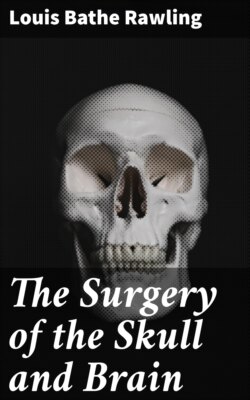Читать книгу The Surgery of the Skull and Brain - Louis Bathe Rawling - Страница 73
На сайте Литреса книга снята с продажи.
DERMOIDS
ОглавлениеTable of Contents
Dermoids, in this region of the body, are almost invariably situated in the middle line between nasion and inion, though cases have been described in which congenital tumours, dermoid-like in nature, were situated over the mastoid process and in other regions.
They occur with the greatest frequency over the anterior fontanelle and in the region of the external occipital protuberance. In the latter situation they are specially prone to possess those deep attachments to the dura mater which are further alluded to below. In the great majority of cases careful examination will show that the tumour occupies a depression in the bone, saucer-like in nature, in which the tumour rests. They are seldom freely movable, and are often markedly fixed, being either attached to the pericranium or to deeper structures. They are not attached to the overlying skin. The tumour is irreducible, and pulsation is absent except in those rare cases where, in the presence of a wide gap in the skull, transmitted pulsation may be obtained.
On careful dissection it may be found that the tumour communicates, by means of a small hole in the skull, with the underlying membranes. In more exceptional cases a wide gap in the skull may be found by means of which the dermoid obtains extensive connexion with the dura mater and even with the brain. In rare cases the dermoid may be pedunculated.
Bland Sutton drew attention to this frequent connexion between the dermoid and the membranes of the brain, showing further that the entire tumour may lie on the inner side of the occipital bone.
The following account affords further information as to the nature and origin of cephalic dermoids.
‘Morphologically considered, the bony framework of the skull is an additional element to the primitive cranium which is represented by the dura mater, and the term extra-cranial should be applied to all tissues outside the dura mater. Early in embryological life the dura mater and skin are in contact; gradually the base and portions of the side wall of the membranous cranium chondrify, thus separating the skin from the dura mater. In the vault of the skull, bone developes between the dura mater and its cutaneous cap, but the skin and dura mater remain in contact along the various sutures even for a year or more after birth. This relation persists longest in the region of the anterior fontanelle and the neighbourhood of the inion. Should the skin be imperfectly separated, or a portion remain persistently adherent to the dura mater, it would act precisely as a tumour germ and give rise to a dermoid. Such a tumour may retain its original attachment to the dura mater, and its pedicle become surrounded by bone; the dermoid would lie outside the bone but be lodged in a depression on the surface, with an aperture transmitting its pedicle. On the other hand, the tumour may become separated from the skin by bone; it would then project on the inner surface or between the layers of the dura mater. If this view of the origin of dermoids be accepted, we must modify our teaching and say that the depressions in which dermoids of the cranium are lodged arise as imperfections in the developmental process, and are not due to absorption induced by pressure; further, the fibrous connexion of such dermoids with the dura mater is primary, not accidental.’[12]
